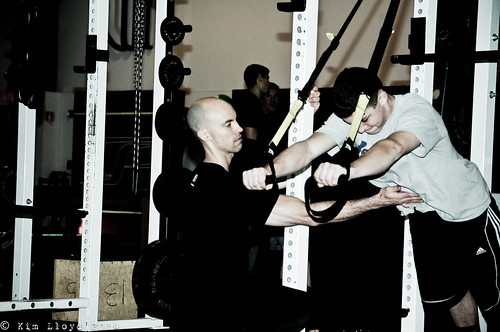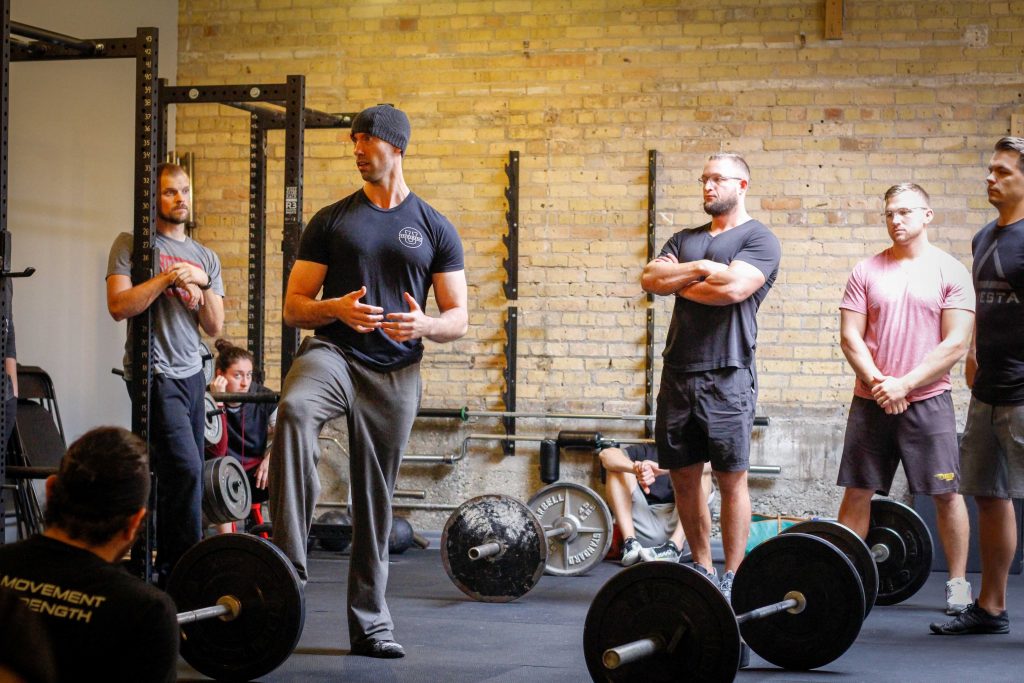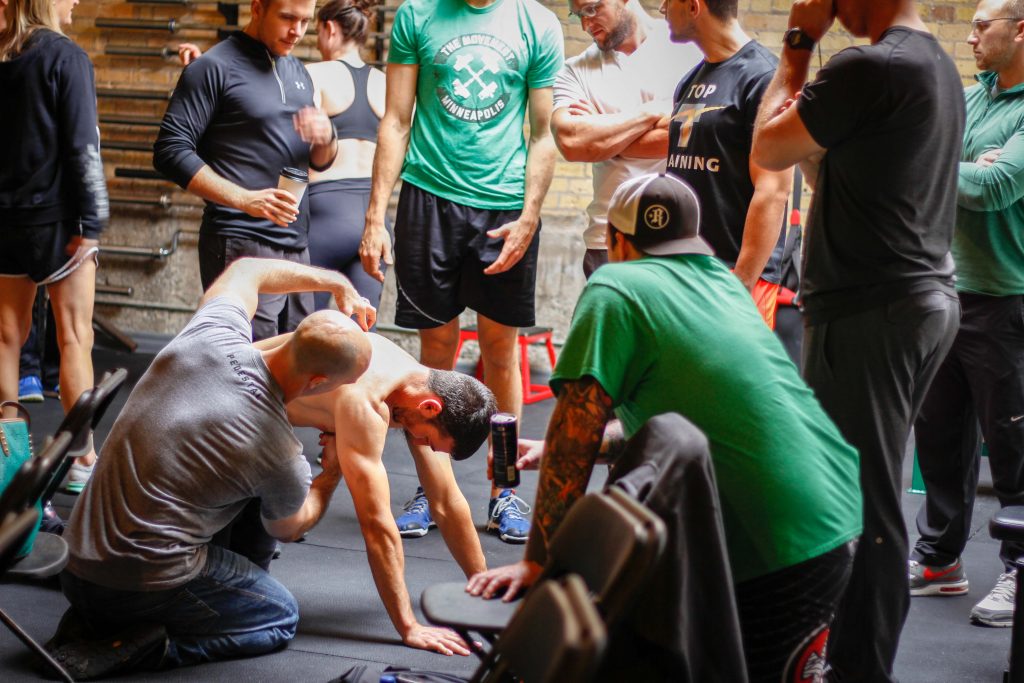One of the biggest honors for me is when other fitness professionals take time out of their schedule to come shadow me or observe what I do at CORE.
Truthfully I don’t feel what I do on a day-to-day basis is altogether revolutionary or going to win me any Nobel prizes in coaching badassery. I mean, I have people deadlift, squat, throw things, and carry stuff, all while listening to some sick techno beats.
No biggie.
However, this was pretty cool and a nice surprise.
Below is a nice write-up by UK based trainer, Stuart Aitken, describing his experience observing me for a few hours a few Saturdays ago.1

4 Things I Learned Shadowing Tony Gentilcore
I walked into CORE, Tony’s small private gym in Boston, for a day of shadowing a few weekends ago.
Here are a few of things I saw within the first 30 minutes of being there:
- Accommodating resistance.
- Accentuated eccentrics.
- Advanced periodization.
- Complicated exercise terminology.
Of course, this wasn’t what I saw and truthfully, there was was nothing special about the way Tony coached, what was special was HOW he coached.

I often think us fitness professionals can be a bit hypocritical.
We tell clients “play the long game,” “stay consistent and good things will happen” and “don’t search for the magic pill, it doesn’t exist,” yet we think we’re one book or course away from solving all of our career issues.
Tony doesn’t programme any differently than I’ve seen him write about, nor does he have a cueing roster that addresses every single movement issue a client has. He still has clients who don’t push their knees out and who need a quick reminder to squeeze their glutes at the top of a hip extension movement.
Perhaps this is what makes Tony, and really any other coach I know, excellent – the basics, done brilliantly.
1) Client-Centered Coaching
I’m a huge fan of constantly checking in with myself about whether I’m being client or philosophy centered.

Lisa, Tony’s wife, talks about this heavily in her work, but for anyone who is reading who hasn’t heard of this before, client-centered coaching would be where you’re taking into the client’s needs and wants into account.
Philosophy-centered would be where you’re putting your philosophies first and forcing square pegs (clients) into round holes (your programming). An example in my career would be when I started to enjoy some gymnastics and started to ‘push’ gymnastics onto the people I work with.
It’s so easy for us to start pushing clients towards what we think is best for them, but when we think about what encompasses effective coaching, this couldn’t be further from how we know clients are likely to respond best.
Think about someone telling you how to do something – how does that you feel? Yes, at times this type of coaching may be necessary, but for the most part, you should be focused on guiding clients towards the decision that is best for them.
Jenny, who is a mum of three and simply wants to feel better, might enjoy doing some deadlifts, but she probably doesn’t want that deadlift to be the only thing she does in her training. Tony loves deadlifting, but not every single one of his clients is going to deadlift, nor will they all “need” to deadlift.
2) Window Coaching
I learnt this off of Tony at a shoulder workshop he ran in the UK earlier this year. Essentially what it means is if you worked in a facility where everyone who walked by could look in and watch, how do you look?
Are you active or are you passive? Are your arms crossed and are you looking disinterested? Is it your tenth session of the day and you look like the last place you would rather be is in the gym?
At one point Tony was dancing to some 90s rap, and at other points, he was either laughing with clients or actively coaching, if you walked past it would look like the kind of environment his type of client would enjoy being in.
Potential clients are always watching.
3) “Move Well, Move Often, Move Under Load”
It wasn’t actually Tony who said this quote but rather my colleague at Lift the Bar, Gregg Slater, but it sums up how I viewed the way Tony has progressed his clients. All of them could hinge, they all knew how to brace, and breath and they all came in early and got on with their warm-ups.

Before you throw a barbell onto a new clients back for squats, do they know how to create tension in their body? Do they know how to disassociate between their hips and upper back so they can hinge effectively? Can they get even MORE out of their sessions by doing their own warm-ups?
Teaching clients how to move well before you start loading them up will not only have a positive effect on their results, but it’ll also decrease the risk of injury.
4) Communication Skills
One of the brilliant things I watched Tony do with each of his clients was the way he related to them. Whether that be in the type of language he used (swearing vs not swearing for example), how much he listened vs spoke, the type of feedback used or right down to the choice of music, his communication skills were appropriate to the client who was in front of him.
I think this is such an under-appreciated aspect of effective coaching; the ability to wear different coaching hats dependent on who you are communicating with.
You know how Susan loves knitting? Make sure you ask about that new scarf she’s working on.
You know how Jonny is a huge football fan (that’s not American football, by the way, that’s good old British football where you kick the ball with your foot)? Make sure you have a glance at the latest football scores.
This kind of stuff matters and to quote Seth Godin:
“A small thing, done repeatedly, is not a small thing.”
If you’re relating to clients, creating an environment that leaves them feeling great, keeping their goal in mind and delivering a quality service, you’ll do well in this industry.
Tony Changed My Life (<– Note From TG: I Wrote That)
Overall I had a fantastic five hours at Tony’s gym, and I can’t recommend doing this kind of thing more often.
There are always others coaches, who are often more experienced, and within a few hours of you, who you could go and shadow.
An afternoon spent with another coach can keep you fresh, allow you the space to level up your coaching and network with other trainers in and around your area, (and it doesn’t even cost anything!) I can’t see any reason why we shouldn’t be doing more of it.
About the Author
Stuart Aitken is the head of member support at Lift the Bar and host at the LTB Podcast, which are both educational services for Personal Trainers. He also works as a Personal Trainer out of Good Health and Fitness in Dundee, Scotland.



